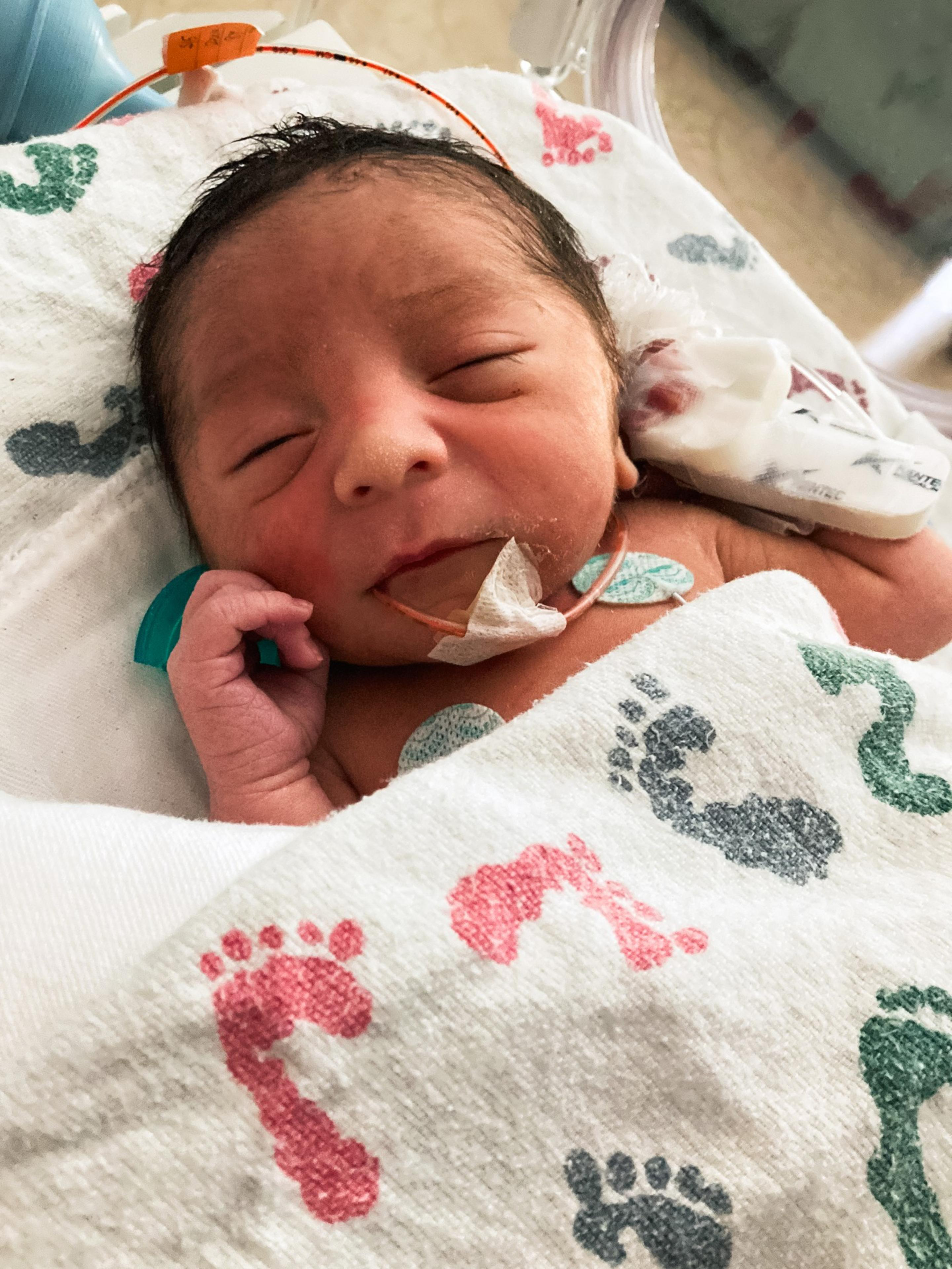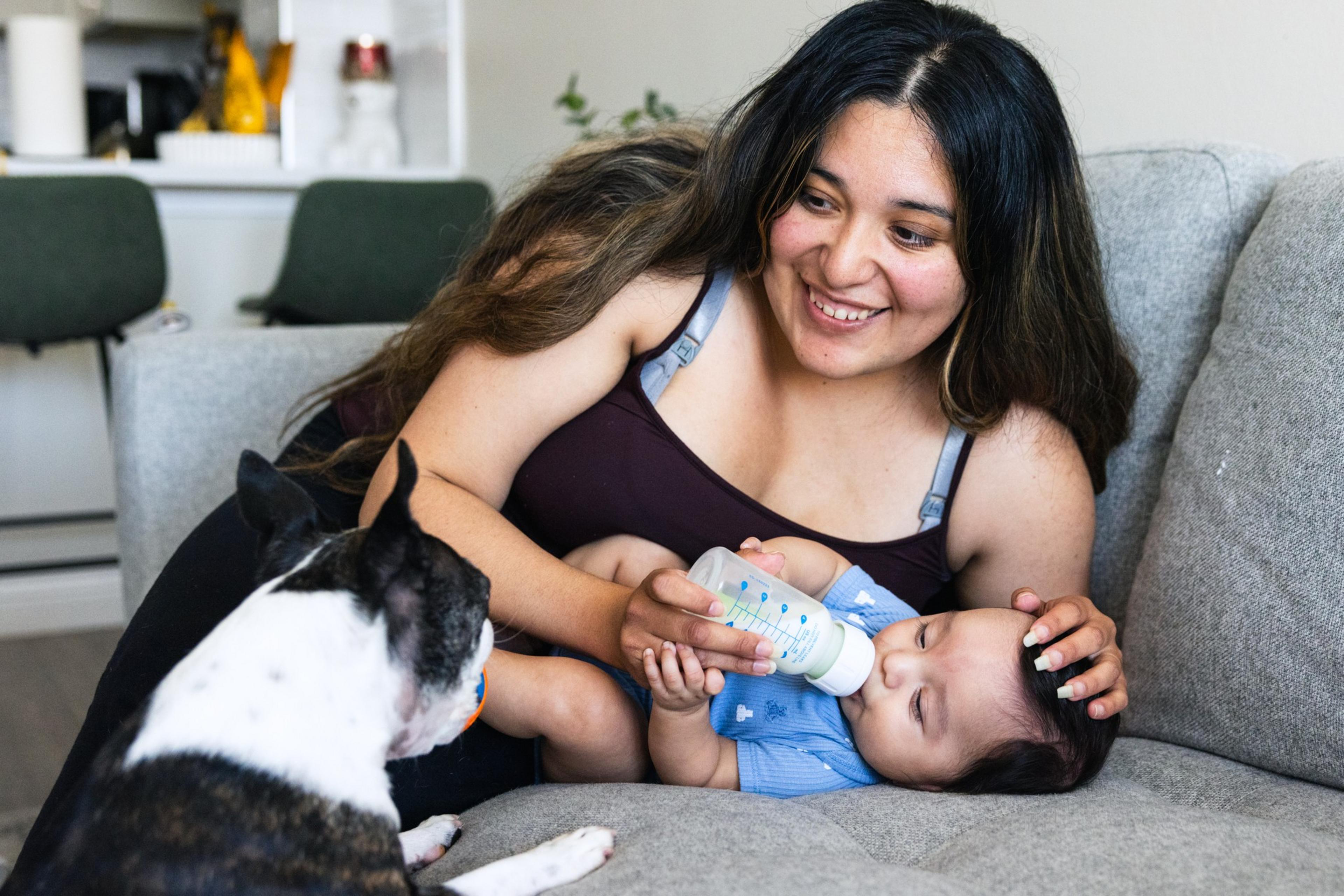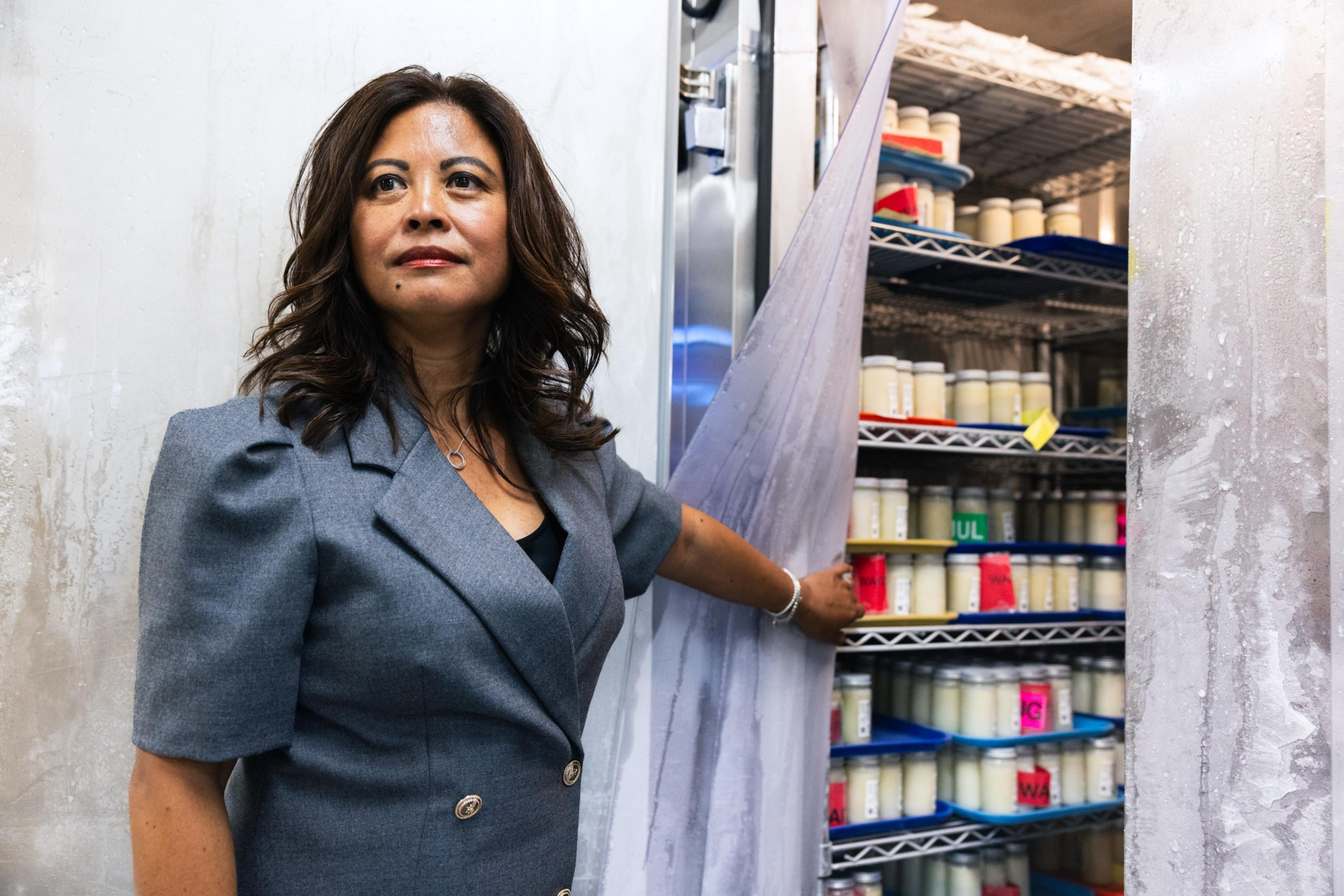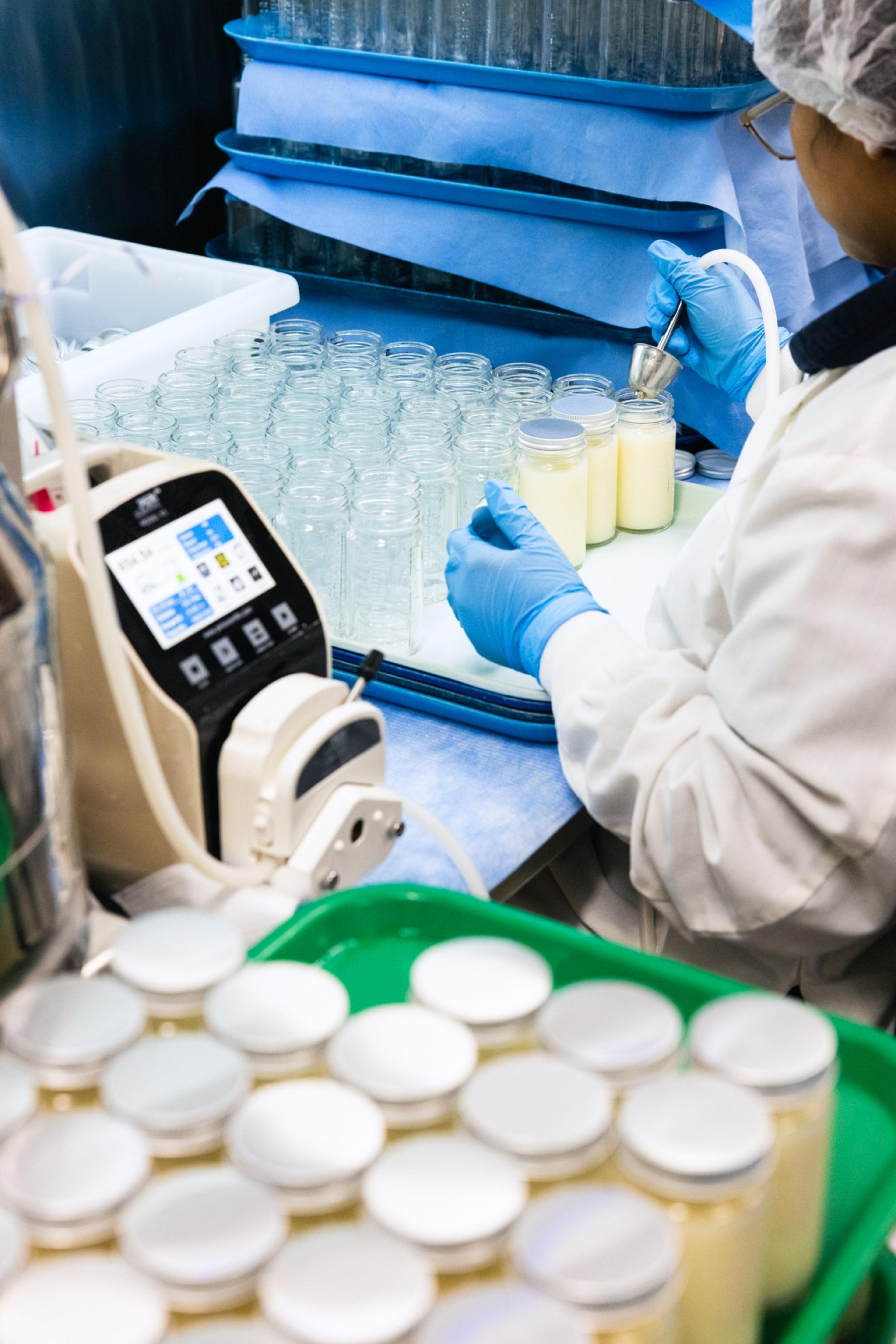When Magali Hernandez sits down to pump breast milk, she alternates between bottle-feeding her son, Franco Ramirez, and playing with his tiny, perfect hands. Although she swears Franco is her husband’s spitting image, mother and son share identical smiles.
At 5 months old, Franco is finally starting to fill out, rolls and dimples marking his squirming body. It’s a far cry from when he entered the world. Franco was born at California Pacific Medical Center in San Francisco with his umbilical cord wrapped around his neck and leg, causing breathing complications that resulted in a five-day stint in the neonatal intensive care unit (NICU).
The shock of the traumatic birth prevented Hernandez’s breast milk from coming in immediately. She felt the acute pain of being denied the ability to bond with her son as he lay in an incubator, covered in tubes. “My baby was in the NICU, and I just wanted to feed him,” she says.
She kept trying to jump-start her milk supply by pumping, but in the meantime, she told nurses she wanted Franco to receive donated human breast milk.


The breast milk that sustained Franco in his first fragile days of life came from Mothers’ Milk Bank California in San Jose. At 50 years old, Mother’s Milk is the country’s longest-running milk bank and has fed thousands of babies.
Every morning, brightly colored coolers filled with specialized plastic bags of donated breast milk arrive at the facility. Many donors have their own babies; others are bereaved by the loss of a child and hope pumping breast milk will help others and alleviate their own pain.
The process of becoming a breast milk donor is not for the faint of heart nor the impatient; it takes about four weeks of health screenings and interviews. “It’s inspiring to see what these women go through to help other families,” said Jennifer Benito-Kowalski, CEO of Mothers’ Milk Bank.


Benito-Kowalski was working in conservation 11 years ago when her son was conceived with the help of a surrogate. She started taking medication to produce breast milk, but when she flew to India for the birth of her son, her supply dried up.
At the time, milk banks didn’t have enough resources to share beyond NICUs, and Benito-Kowalski was forced to turn to an unregulated milk-sharing website. She was frightened when her son rejected the milk. “We just put so much pressure on ourselves as women, and I couldn’t believe what I had just done, so I dumped it all out,” she said.
She turned to formula, but the experience informed her role at the milk bank, which she assumed last year. “It’s a personal mission to help families in my situation who wanted that option and didn’t have it,” she said.

Lab technicians at Mothers’ Milk Bank are careful not to waste a single drop, wearing lab coats, gloves, and hairnets as they handle the pasteurization process. The milk is pasteurized over a longer time period and at a lower temperature than is typical for cows’ milk, so that potentially harmful bacteria are destroyed and beneficial nutrients are left intact.
The breast milk is tested by the Santa Clara County Public Health Department then shipped to hospitals and individual recipients. The milk bank serves clients in Nevada, Arizona, Hawaii, Idaho, and Maryland, but is mainly focused on the Bay Area.
Some of the milk processed at the bank travels just six miles to the Santa Clara Valley Medical Center NICU.


It’s a quiet place; the beep of machines is often louder than the cries of the critically ill patients. Most NICU babies were born premature; others have diseases or were born to women struggling with addiction to drugs or alcohol. Many infants lack a complete gut lining, which can become a serious health hazard. Lactation nurse coordinator April Grady said donated breast milk has an outsize impact on some of the hospital’s smallest and sickest patients.
“It is literally lifesaving for these babies to start with human milk,” she said.
One of the biggest concerns for all babies in the NICU is necrotizing enterocolitis, intestinal inflammation that can cause a fatal bacterial infection. Infants who are fed breast milk are up to 10 times less likely to develop NEC than those who receive infant formula.
Despite the benefits of donor breast milk, about 12% of California NICUs do not offer it. However, access may be expanded soon. In September, Gov. Gavin Newsom signed AB 3059, which allows hospitals to store and distribute breast milk without obtaining a tissue bank license. Lawmakers hope the relaxed regulation will close the gap in health outcomes for Black and Latino infants, who are 60% more likely than white babies to suffer from NEC, according to the bill’s authors (opens in new tab).


Grady likens donating breast milk to donating blood in terms of its lifesaving potential. For Jennifer Bruce, proof of the benefits of donor milk is swaddled in her arms. She was 26 weeks pregnant in July, when Mathew was delivered via crash C-section. At birth, he weighed in at 1 pound, 12 ounces; now, nine weeks later, he has gained nearly 3 pounds.
Although Bruce is now producing breast milk, Mathew was reliant for the first week of his life on donations from the Mothers’ Milk Bank down the road. “Without that donor milk, I don’t know where we would have gotten,” Bruce said, gazing at her son on her bare chest. “I’m eternally grateful for whatever mother did that for my son.”

Benito-Kowalski says that although the laws have changed, milk banks remain in desperate need of donations. On average, women donate for nine months to a year at a time. “The cycle of a milk donor is so short that we’re constantly needing milk,” she said.
However, the larger issue the bank faces is one of awareness. Despite Mothers Milk celebrating its 50th anniversary (opens in new tab) earlier this month, many people have still never heard of milk donation. Benito-Kowalski believes normalizing the donation and distribution of breast milk can build “a kinder community.”
“You’re really giving love and hope to people in these situations,” she said.
When Hernandez gave birth to Franco, the experience was less joyful than she had imagined. She felt like a failure for having a sick child and being unable to breastfeed him, and that only compounded the fear and anxiety of seeing him in the NICU. “I just remember seeing him with all these tubes, and I just wasn’t expecting that,” she said, her voice cracking.


Once Franco recovered with the help of donor milk and Hernandez began producing breast milk, she decided to give back some of the love and support she had been given. She has donated more than 500 ounces to the Mothers’ Milk Bank and has no plan to stop soon. She said pumping breast milk for donation as she plays with her son has helped them bond, and knowing her milk is benefiting babies and parents in need has been a crucial part of healing her trauma.
When she dropped off her most recent donation, Hernandez received a photo of an infant in the NICU who would benefit from breast milk; the resemblance to her son was so great that she initially had a hard time looking at it. However, she now keeps the image on her refrigerator as a reminder of why she continues to donate breast milk.
“When I wake up at two in the morning to pump, I’m not only pumping for Franco, but I’m pumping for other babies that will get this donation and will hopefully leave the NICU soon,” she said. “Donor milk helped save us. I’ve been trying to pay that forward since he was donated to. It was a great gift.”

